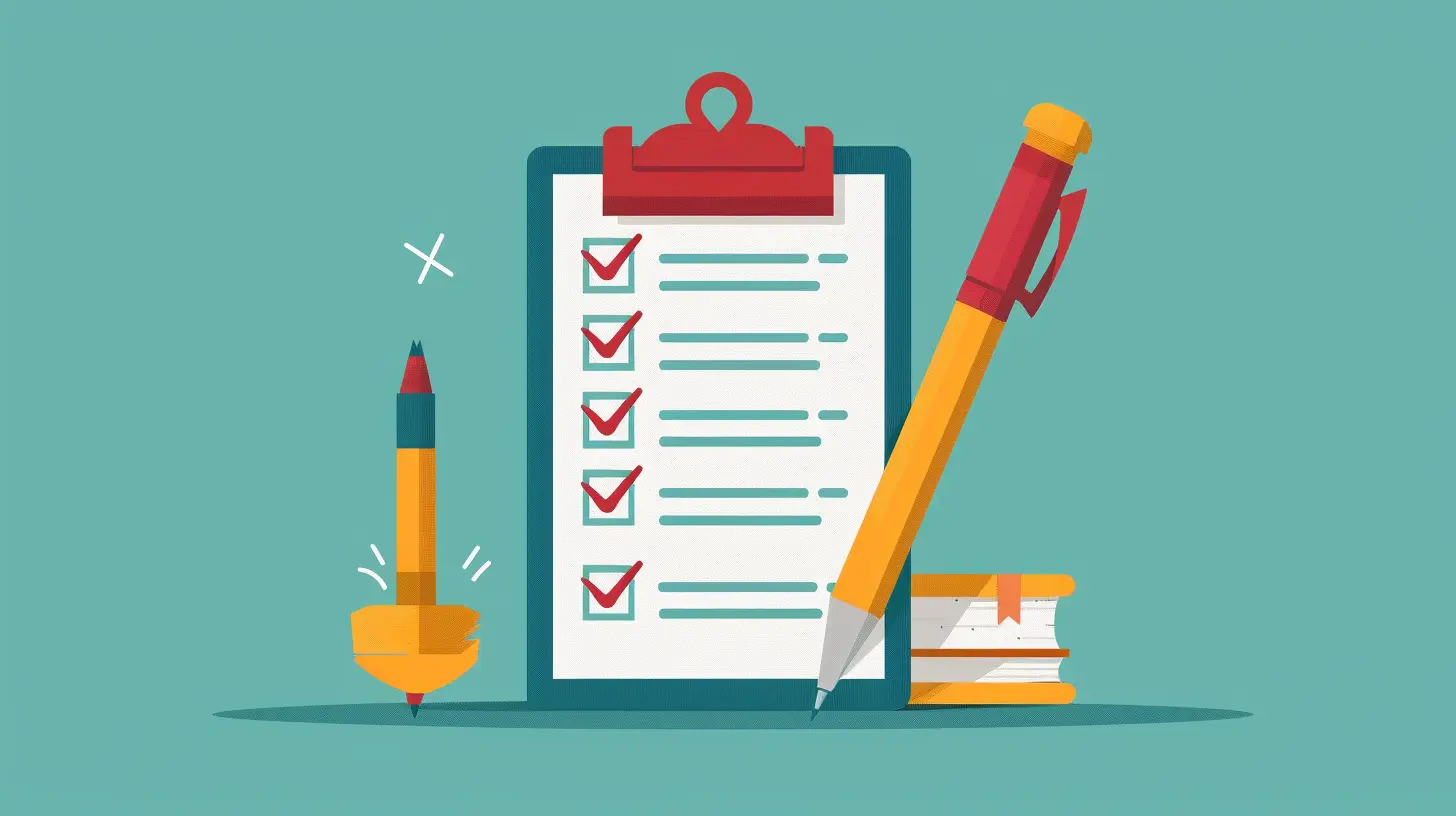How to Use Self-Assessment to Create a Personalized Study Plan
27 May 2025
If you're like most students, you've probably tried different study techniques, hoping one would magically improve your grades. But the truth is, there's no one-size-fits-all study plan. What works for someone else might not work for you. That’s where self-assessment comes in. By understanding your own strengths, weaknesses, learning style, and study habits, you can create a personalized study plan tailored just for you.
In this article, we’ll dive into the step-by-step process of using self-assessment to craft a study plan that’s not only effective but also sustainable. So, grab a notebook and let’s get started!

What is Self-Assessment?
Before we jump into the details, let’s clarify what self-assessment actually means. Self-assessment is the process of evaluating your own abilities, understanding your learning style, and recognizing areas where you need improvement. It’s about taking an honest look at yourself to figure out what’s working and what’s not.Think of it like a roadmap. If you don’t know where you are, how can you expect to reach your destination? You need to understand your starting point before you can make progress.
Why is Self-Assessment Important?
Let’s be real: studying is hard. It can feel overwhelming, especially if you don’t have a clear plan. But self-assessment helps you develop a roadmap. It makes your study sessions more focused and efficient. Instead of wasting time on things you already know, you can focus on areas that need improvement.Self-assessment also helps boost your confidence. When you know your strengths, you can lean into them. And when you’re aware of your weaknesses, you can confront them head-on. The end result? A more balanced and effective study routine.

Step-by-Step Guide to Self-Assessment for a Personalized Study Plan
Step 1: Assess Your Current Academic Performance
The first step in creating a personalized study plan is to take a good, hard look at your current academic performance. This isn’t about beating yourself up over a bad grade or patting yourself on the back for doing well. It’s about understanding where you stand.Ask yourself questions like:
- Which subjects or topics do I excel in?
- Where am I struggling the most?
- What are my current grades or scores in each subject?
You could also look at past assignments, quizzes, and exams to see where you tend to lose points. This will give you a clear indication of your strengths and weaknesses.
Step 2: Identify Your Learning Style
Do you remember more from listening to a lecture or from reading the textbook? Do you prefer group study sessions, or do you work best alone? Everyone has a unique way of learning, and understanding your learning style is key to creating an effective study plan.Here are some common learning styles:
- Visual Learners: Prefer to learn through images, diagrams, and written instructions.
- Auditory Learners: Retain information better when they hear it; benefit from discussions and lectures.
- Kinesthetic Learners: Learn best by doing, using hands-on activities and real-life examples.
- Reading/Writing Learners: Grasp concepts best through reading and writing down information.
Once you know your learning style, you can tailor your study methods accordingly. For example, if you’re a visual learner, use mind maps or flashcards. If you're auditory, try listening to educational podcasts or recording lectures.
Step 3: Set Clear and Achievable Goals
Now that you’ve assessed your performance and learning style, it’s time to set some goals. But here’s the thing: your goals need to be realistic. Don’t aim to master an entire textbook in a week. Instead, break down larger goals into smaller, more manageable tasks.For example:
- Big Goal: Improve your math grade by 10 points.
- Smaller Goals: Practice algebra for 30 minutes every day, complete two practice tests each week, and review class notes after every lesson.
Setting goals will give your study plan more structure and direction. Plus, you’ll feel more motivated as you check off each smaller task on your way to that big goal.
Step 4: Pinpoint Your Strengths and Weaknesses
You already have an idea of your academic strengths and weaknesses from your self-assessment, but now it's time to dig deeper. Why are you struggling in certain areas? Is it because you don’t understand the material, or is it because you’re not dedicating enough time to it?Try to be as specific as possible. For example, instead of saying, “I’m bad at math,” you might say, “I struggle with geometry because I don’t fully understand the formulas.” This level of specificity allows you to focus your efforts where they’re truly needed.
On the flip side, don’t forget to acknowledge your strengths! If you’re great at writing essays, use that to your advantage. Maybe you can spend less time on English homework and allocate those extra hours to a subject where you’re struggling.
Step 5: Design a Study Schedule
Now comes the fun part: designing your personalized study schedule. Here’s where everything comes together. Based on your goals, strengths, weaknesses, and learning style, design a study plan that will work best for you.Here are some tips for creating an effective study schedule:
- Prioritize Weak Areas: Spend more time on subjects where you struggle.
- Break It Up: Don’t cram everything into one day. Spread your study sessions over the week.
- Block Out Time: Dedicate specific time slots for studying. This will help you build a routine.
- Be Realistic: Don’t schedule 5-hour study sessions if you know you can only focus for an hour.
- Incorporate Breaks: You need rest to stay sharp. Use techniques like the Pomodoro method (25 minutes of studying followed by a 5-minute break) to keep your brain fresh.
Step 6: Use the Right Study Resources
Now that you have a study schedule, it’s time to gather the right resources. This could include textbooks, online tutorials, flashcards, or educational apps. Choose resources that suit your learning style—whether it’s visual aids, podcasts, or interactive quizzes.For example:
- Visual learners could benefit from platforms like YouTube or Khan Academy, which offer engaging videos.
- Auditory learners might prefer listening to audiobooks or educational podcasts.
- Kinesthetic learners could try hands-on activities or experiments related to their subjects.
Don’t be afraid to experiment with different resources until you find what works best for you.
Step 7: Review and Adjust Regularly
Your study plan shouldn’t be set in stone. As you progress, you’ll find that some strategies work better than others. Maybe you realize that you need more time for math and less time for history, or perhaps you discover a new resource that’s incredibly helpful.Make it a habit to review your study plan every couple of weeks. Ask yourself:
- Am I sticking to my schedule?
- Are my study methods working?
- Am I making progress toward my goals?
Based on your answers, adjust your plan as needed. Flexibility is key to maintaining a study routine that works in the long term.

Common Mistakes to Avoid During Self-Assessment
While self-assessment is a powerful tool, it’s easy to fall into a few traps along the way. Let’s look at some common mistakes and how to avoid them:1. Being Too Hard on Yourself
It’s easy to focus solely on your weaknesses and beat yourself up over them. But self-assessment should be an objective process. Balance your weaknesses with your strengths, and focus on improvement rather than perfection.2. Setting Unrealistic Goals
Ambition is great, but setting unattainable goals is a recipe for frustration. If your goals are too big, you’ll quickly get discouraged. Start small and build up over time.3. Not Adjusting Your Plan
Your initial study plan won’t always be perfect—and that’s okay! The key is to review and adjust it regularly. If something isn’t working, don’t be afraid to switch things up.
Final Thoughts
Self-assessment is the key to creating a personalized study plan that works for you. By taking the time to understand your academic performance, learning style, strengths, and weaknesses, you can design a study routine that’s not only effective but also sustainable.Remember, your study plan is a living document. It will evolve as you progress, and that’s the beauty of it. With a little self-reflection and a solid plan, you’ll be well on your way to achieving your academic goals.
So, what are you waiting for? Grab that notebook and start your self-assessment today!
all images in this post were generated using AI tools
Category:
Self AssessmentAuthor:

Anita Harmon
Discussion
rate this article
3 comments
Alyssa Bryant
This article offers valuable insights on self-assessment and its role in developing tailored study plans. Implementing these strategies can significantly enhance learning outcomes and foster a more personalized educational experience. Great job!
June 13, 2025 at 2:24 AM

Anita Harmon
Thank you for your thoughtful feedback! I'm glad you found the insights on self-assessment helpful for creating personalized study plans.
Nadia McAndrews
Self-assessment isn’t just a buzzword; it’s your secret weapon! Ditch the cookie-cutter plans and tailor your study strategy like the academic boss you are!
May 29, 2025 at 2:20 AM

Anita Harmon
Absolutely! Self-assessment empowers you to identify your strengths and weaknesses, allowing you to customize your study plan for maximum effectiveness. Own your learning journey!
Yvonne Conrad
This article sparks intriguing ideas! I'm eager to explore how self-assessment can truly tailor my study strategies effectively.
May 27, 2025 at 11:36 AM

Anita Harmon
Thank you! I'm glad you found the article inspiring. Self-assessment is a powerful tool for personalizing your study approach. Happy exploring!


